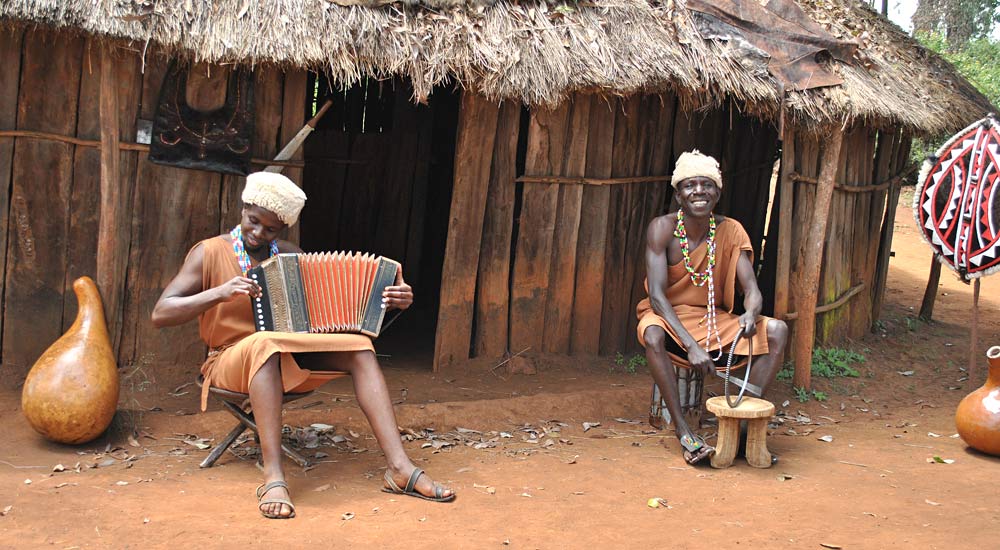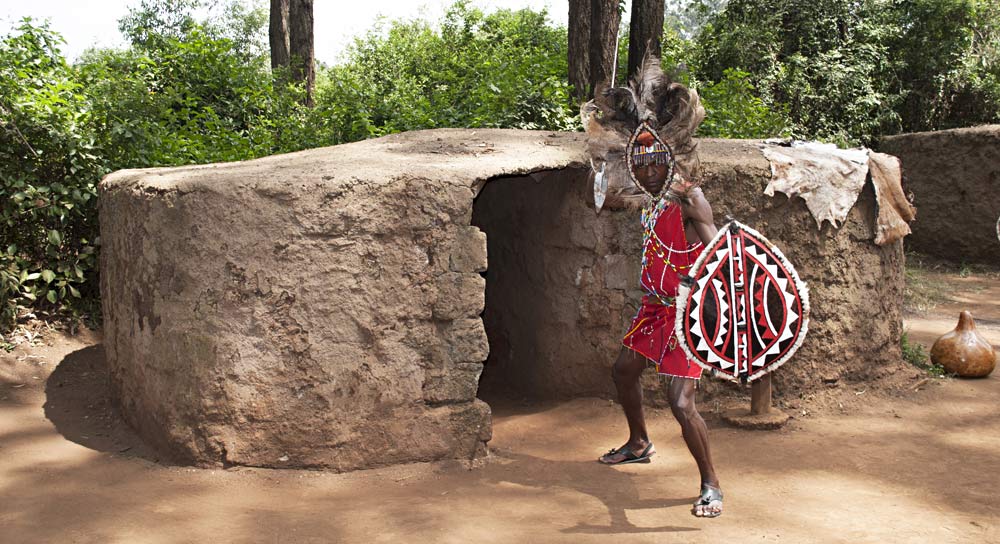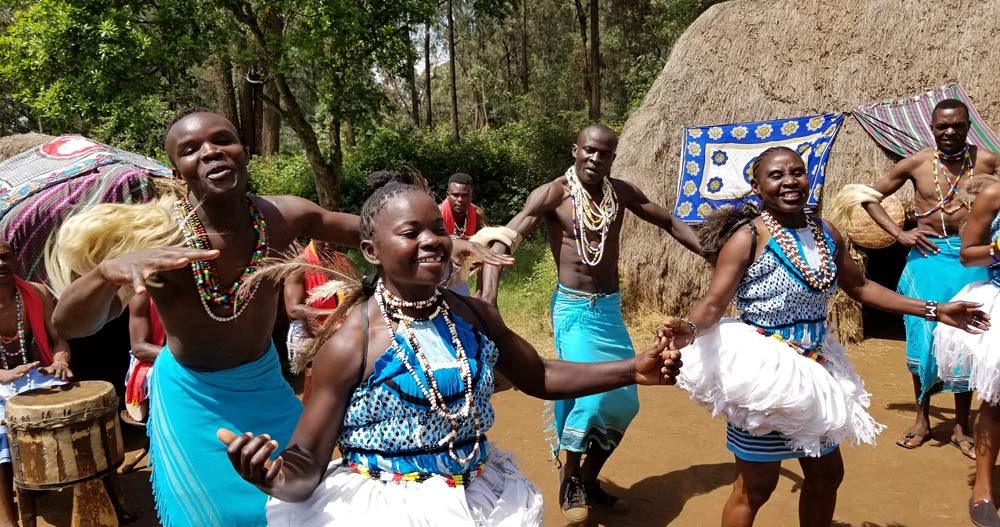The Bomas of Kenya offers an unprecedented insight into the authentic cultural heritage of Kenya. Something of a time machine, it has captured an ethnic snapshot of a fascinating range of cultures, many of which are fast disappearing under the onslaught of the technological age. The Bomas of Kenya is a highly popular day trip when in Nairobi… so we went to check it out.
If you’d come to the Bomas of Kenya expecting to see a traditional Maasai dance performance you’d have been disappointed. Instead of the rhythmic chanting that typifies a Maasai dance, there’s a man in a cowboy hat playing an accordion: another holds a metal ring that he plays not unlike an orchestral triangle. It could be an American barn dance. And, instead of the gravity-defying jumps of the Maasai warriors, these dancers are paired into couples and follow a stately progression around the floor holding each other studiously at arm’s length.

The Mwomboko dance
If you didn’t know better you might be tempted to say that they’re dancing a parody of a waltz. And you wouldn’t be far wrong because this performance at the Kenyan Cultural Centre known as The Bomas of Kenya is an authentic rendition of the Mwomboko dance of the Kikuyu people. And it’s actually a tongue-in-cheek copy of the fox trot.
Surreal, elegant and quaintly romantic, the Mwomboko was born in the 1930s to 1940s era of colonial East Africa. Some say it was the result of the Kikuyu people having watched the British colonials dancing the waltz at their evening parties, many of which were rather colourfully decadent. Others say that the Kenyan foot soldiers of the First World War copied the dance from the waltzes, Scottish dances and fox trots that they watched their then colonial masters dance during the war. Whatever its origins, the Mwomboko became an instant hit amongst the Kikuyu and remains one of their most popular dances to this day.
But there’s a darker side to the history of Mwomboko, whose name evolved from the Kikuyu word for ‘eruption’. It seems that the Kikuyu were in the habit of weaving certain gestures into their traditional dances, such as the Murithingu dance, that spread anti-colonial messages. So, with sweeping finality, the British banned all such dances. It didn’t work.
In retaliation, the Kikuyu came up with the Mwomboko, which the British found hard to disapprove of. It was, after all, a seemingly innocent copy of their very own dance traditions. What the British didn’t know however was that the Kikuyu were not only using the Mwomboko to continue to pass on messages of rebellion but also to poke fun at the British.
Preserving Kenyan tradition
It’s a great story and the living embodiment of a fragment of history: it’s also just one of the many fascinating tales that lie behind the fifty or so dances preserved in the living archive of The Bomas of Kenya.
Established as a repository for the preservation of Kenyan tradition, The Bomas not only safeguards Kenya’s dance traditions, but also her music, cuisine, cultural artefacts and lifestyles. But it does so with a dedication to detail that would do credit to the most exacting of museums.
Every dance is researched in the region of its birth. Musical instruments are made according to ancient traditions using raw materials that are anthropologically correct and, when such things as colobus skins, kudu horns or monitor lizard hides are required, these are sustainably sourced from the Kenya Wildlife Service. Choreographers study the steps, musicians write down the music, designers replicate the costumes, local singers perform the songs, and very slowly the dance performance is moulded into a thing of ethnic perfection.

And even that’s not good enough for the eagle-eyed culture vultures of The Bomas. Because, when they have finally perfected the dance to the best of their ability, a delegation of community elders is invited down to Nairobi to assess the finished performance for precision of footwork, costume, lyrical enunciation and style of playing. And the elders don’t hold back when it comes to correcting anything that is not absolutely true to their fiercely protected ethnic history.
Traditional villages
The same attention to detail is brought to bear with the representations of the ethnic villages that dot the extensive grounds of The Bomas of Kenya. Laid out in exact replica of a traditional village, complete with grain stores, look-out posts and cattle enclosures, every hut has been hand-made by ethnically correct craftsmen and all the materials, even the mud, is regionally sourced. None of which makes for easy maintenance.

A Rendille hut, for instance, is built to withstand immense heat and profound drought, and struggles to remain standing amid the periodic deluges and chill of Nairobi. And then there’s the baboons. Situated immediately adjacent to Nairobi National Park, The Bomas of Kenya is a potent baboon draw, which is unfortunate because the baboons like nothing better than to methodically un-thatch the huts so carefully thatched by the cultural experts.
Cultural dance performances
Back on the dance floor, beneath the vast vaulted ceiling of the central pavilion, which was itself inspired by the traditional African hut, the Mwomboko has been replaced by a Kisii dance called the Rigesa, which originates from Nyanza. Now the musician plays a traditional obokano or 8-stringed lyre and instead of parodying the British, the dance tells the story of the Kisii migration from Uganda. And, if you watch carefully, you’ll see that representations of all the fearful animals the people met on their perilous journey have been woven into the dance – lions, elephants, leopards, buffalos and more.

Next comes a display of Chuka drumming, which originated amongst the Embu people of Eastern Kenya. The dancers, all male, bare-legged and muscled of arm are clad in provocatively short swaying rope skirts and hold huge cylindrical drums between their legs. The phallic inference is inescapable and history recounts that originally the dance was performed only for unmarried women in order that they might choose a husband. ‘We had to tone it down a bit for some of the performances,’ confides the choreographer in the darkness, ‘especially when we get a school party.’
There’s a 50-strong group of small school children in the audience – they’re rapt. On the front row, a diminutive boy is head-banging with all the conviction of a heavy metal addict. Two other little boys are thrusting their hips back and forth at each other in time with the drumming. It seems that the toning-down has not been entirely successful. Which is exactly as it should be.
The Bomas of Kenya – need to know
There are daily dance performances at The Bomas and guests are welcome to wander amongst the ethnic villages. The dancers can also be hired for special performances and there’s a burgeoning trend for weddings to be staged against the backdrop of a specific village accompanied by authentic ethnic dance and food from the onsite restaurant.
The Bomas of Kenya also offers a wide range of conference and meeting spaces and team-building pursuits.
Daily Performances:
Monday to Friday: 2:30 pm to 4:00 pm
Weekends and Public Holidays:
3:30 pm to 5:15 pm
For more information: www.bomasofkenya.co.ke
© 2024 Kenya Holidays
